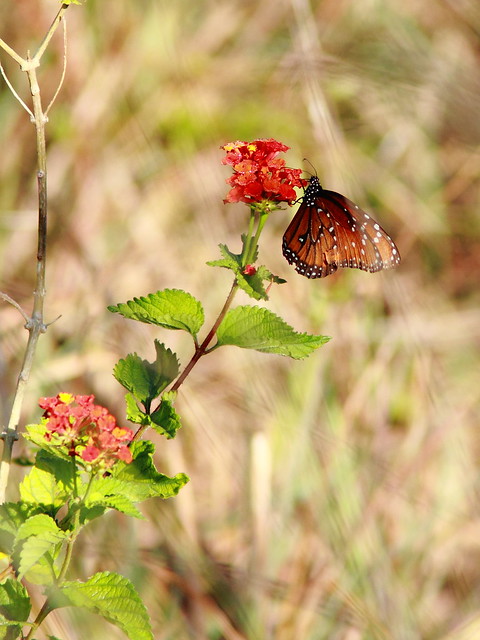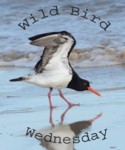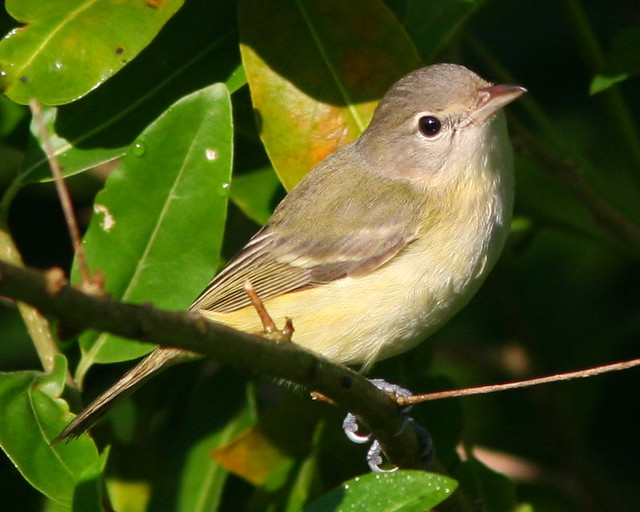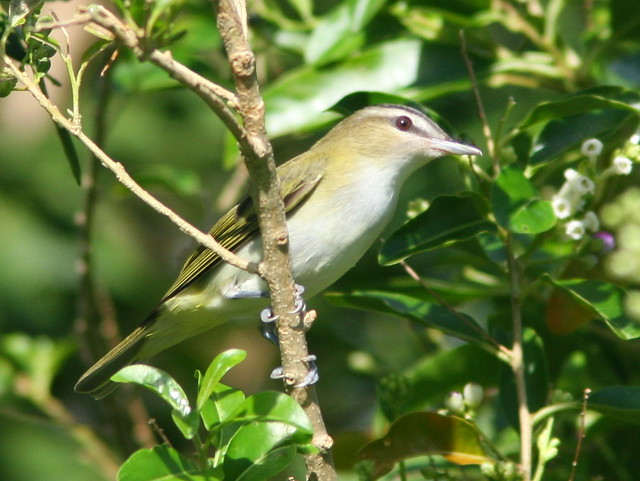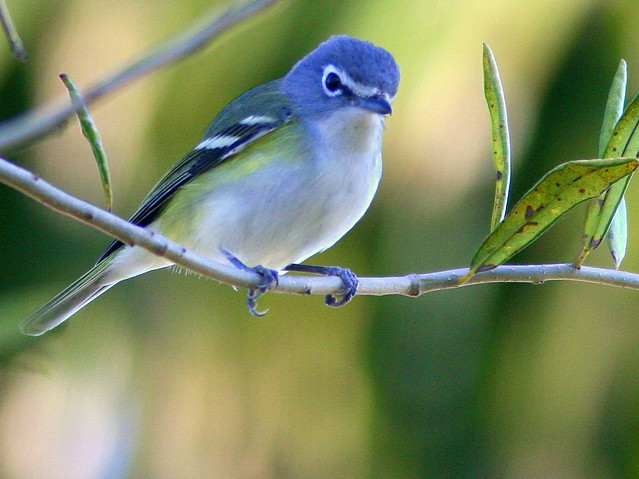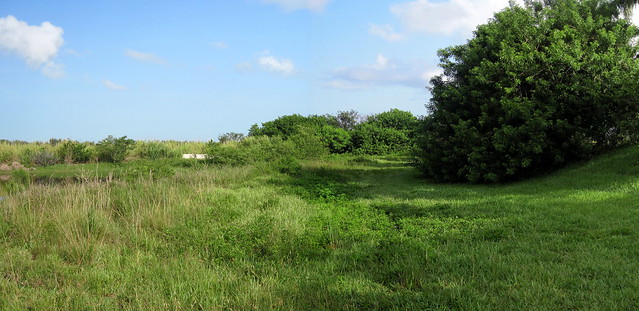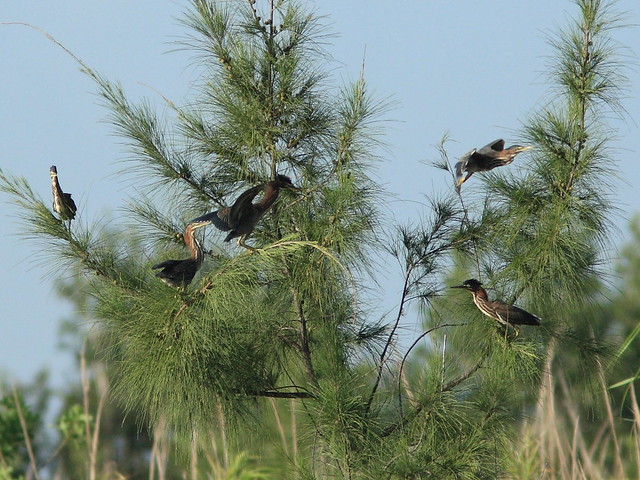Posted by: Ken @ 1:00 pm
It was about 15 minutes after sunrise and cloudy when Mary Lou and I approached the bend in the road at the junction of the unpaved portions of Miramar Parkway and SW 196th Avenue. I had pre-set the ISO at 800 (aperture open all the way to f/5.6) but did not expect to take any photos until after we completed the fast-paced “aerobic” mile into the wetlands adjacent to our subdivision. Only about a quarter mile into our walk, we suddenly saw a Bobcat standing almost in the middle of the road, about 100 yards away.
This was the first time one had posed out in the open roadway like that. We slowly moved up to about 50 yards before the cat fled. Unfortunately, I had kept the camera in an air conditioned room, and the lens fogged up pretty badly in the stifling heat and humidity. I wiped them a few times, but the quality of all the photos suffered.
This was about the sharpest image I got, so I processed it a couple of different ways. The above one is made up of four layers on the cropped original RAW image, each with a different exposure compensation (-1.0, -0.5, +0.5 and +1.0), thus producing an HDR-like effect. The cat suddenly fled towards the levee path that follows south along the 196th Avenue Canal.
I followed the Bobcat’s retreat route up along the levee path, but never caught sight of it again. However, I found very fresh Bobcat scat. The Bobcat dropped these feces out in the open with no attempt to conceal them, suggesting it was a male. Females usually deposit it less conspicuously and often scratch dirt over it as do House Cats. Note heavy black “tar” color due to digested blood, characteristic “Tootsie Roll” segmentation, large bore (~1 inch), inclusion of much hair and few bone fragments.
Three female White-tailed Deer appeared up ahead and walked towards me. I stood motionless , but the sun was getting higher and I became uncomfortably hot and finally started to move into a shady area. This frightened the does. It is a treat to see them here, as they are not very abundant.
I gave up my attempt to stalk the Bobcat and checked out the birds. A Loggerhead Shrike looked down at me from the top of a shrub.
Moving back down the what is left of my “Fake Hammock,” I took a spot in the shade and waited to see which birds might show up. This Northern Mockingbird was one of several moving about.
Predictably, a Prairie Warbler came out of hiding.
An Ovenbird peered out from the deep foliage.
Several Brown Thrashers have congregated in this area, more often heard than seen. This one flew out into the open.
A pair of Common Yellowthroats busily foraged in the low vegetation. The male briefly came out into the light.
Palm Warblers have arrived in good numbers. All are of the somber Western subspecies. Oddly, the east coast birds turn to the southwest before reaching Florida and the Gulf of Mexico, on their way to spend the winter in Texas and Mexico. Their paths cross with the western population, which flies SE to winter in Florida and Cuba. They reverse the criss-cross pattern when returning north in spring.
Suddenly a Northern Waterthrush walked out of the darkness unto a small limb, its tail slowly bobbing characteristically.
The waterthrush paused to look me over before flying off.
A Bald Eagle flew over, tracking a perfect line from its nesting area two miles northwest in Pembroke Pines to the large lake in our subdivision. For updates on our local eagle nest, visit my Bald Eagle Nest Watch FORUM.
On the way home, I saw several White-winged Doves lined up on a neighbor’s roof.
Posted by: Ken @ 8:33 am
We returned to our south Florida home one week ago, and it has rained every day. The weather allowed us only two short forays into the wetlands adjacent to our home.
This morning’s sunrise was typical. Light rain was dappling the surface of our lake and a thunderstorm was moving in from the southeast (right) as I took this photo from our patio.
Local birders have been reporting decent numbers of warblers migrating through our area, so they were my main objective on our first morning out. Along the unpaved road that leads into the wetlands, I got a quick shot of a Great Egret.
An adult Bald Eagle flew over towards our subdivision from the direction of its nesting area about a mile away in Pembroke Pines.
After Mary Lou and I finished the “aerobic” portion of our walk along the gravel road, I stayed behind at the place that I formerly called the “Fake Hammock.” It is now only the ghost of its former glory days, as all the large trees were cut down by recreational RV users who built a fire pit in the center of the small clump of trees and shrubs.
After an absence of over six weeks, I was disappointed to find that the clear shady area under the canopy where I used to sit and wait for the birds is now in full sunlight with grasses and vines up above my chest. Since I did not have my snake boots I did not venture inside the “hammock.” Instead I birded its margins. The morning light was nearly perfect.
The first warbler to appear was an American Redstart.
An inquisitive Blue-gray Gnatcatcher approached quite closely.
Four Brown Thrashers had gathered to feast on the berries of a Trema tree nearby.
I had trouble identifying this flycatcher as it seemed rather small, suggesting it was an Alder Flycatcher rather than an Eastern Wood-Pewee. However, its peaked head and slight hook at the end of its bill confirmed it was the latter species. Click on the image for more photos and discussion of its identification.
This male Northern Cardinal has nearly finished its post-breeding molt and looks good in his fresh coat.

On my second visit to the hammock area I saw more warblers. A Northern Parula made its first appearance.
Prairie Warblers provided some splendid views. Here is a male.
The female Prairie Warbler has more subdued markings, but I liked this pose.
A Northern Waterthrush paid a brief visit. I was lucky to catch it through the foliage.
A female Common Yellowthroat was likewise quite elusive.
When I was about to leave, I was startled a very loud splash in the nearby canal. I spun around to catch a parting shot of the unsuccessful fisherman, an Osprey.
Not to be overlooked was this Band-winged Dragonlet…
…a Zebra heliconian…
…and a Halloween Pennant.
Posted by: Ken @ 1:52 pm
Since taking up photography I have become a more sloppy birder. A pair of binoculars is the best tool to identify a small bird weaving in and out of sight among the branches. If you plan to take a photo of a bird it helps to know what kind it is. Sometimes I have gotten killer binocular views of birds, only to have them disappear the moment I reached for my camera. As a result of such experiences, I often give in to the temptation to raise my camera first.
Although my 420 mm telephoto lens system (an EF300mm f/4L IS USM coupled with a 1.4x extender) provides approximately the same magnification as 8 power binoculars, its viewfinder offers a far less adequate image. In the first place, the field of view is restricted by the camera’s telescopic lens, making it more difficult to find and track the movement of an active target. The view is not nearly as bright as that provided by binoculars. Further, the camera’s image is only in two dimensions, so it is impossible to “see around” the leaves and twigs that may obstruct important identifying features of a small bird. The camera’s auto-focus feature presents an additional challenge, as it will sometimes pick out a little twig that you failed to see in front of the bird, turning the intended target into nothing but a blur.
Case in point. This week, in Kane County, Illinois, I photographed a Philadelphia Vireo for the first time, but did not know this until after I got home. I had heard its song, which I find hard to distinguish from that of the Red-eyed vireo, and then caught a glimpse of what I thought to be just another Warbling Vireo. After taking a few hasty shots, I returned to my search for migrating warblers.
The “Gilvus” group of vireos includes these three rather similar species. Here is a recent photo of the locally common Warbling Vireo, Vireo gilvus.
Take a close look at my next photo, of the overlooked Philadelphia Vireo, Vireo philadelphicus. It is quite similar to the Warbling vireo, but shows a brighter yellow breast and the black line through its eye extends out in front of the eye. I noticed this only after seeing its image displayed on the computer screen.
Bell’s Vireo, Vireo bellii, also included in the Gilvus group, has more subdued plumage. Its normal range is the Central and Western US, but I found this one in Florida, also in my “Fake Hammock.”
I thought vireos got their name from their songs, which are usually rather brief and disconnected phrases that sometimes sound like “vireo… vir-de-lee-o… viree-ee…” However, In Latin, “vireo” means “to be green.”
Although all vireos display a more or less greenish cast to their plumage, the “Green-backed” group is aptly named. It includes the Red-eyed Vireo, Vireo olivaceus.
The Black-whiskered Vireo, Vireo altiloquus, resembles a Red-eyed with a penciled Fu Manchu mustache. This was my first sighting and only photo opportunity, in what I called the “Fake Hammock” near our South Florida home.
Members of the “Eye-ringed” group of vireos appear to be wearing spectacles. This is a Blue-headed Vireo, Vireo solitarius, photographed in direct sunlight, which accents the cool blue color of its head and legs. In poor light the head often looks more gray, as the blue is due to scattering of blue light by the structure of its feathers, not a blue pigment. Unlike the bright blue iridescence of peacocks and grackles, which is caused by reflection of light, the structural blue color is present under nearly all lighting conditions.
The White-eyed Vireo, Vireo griseus, is common as a breeder and winter visitor in South Florida.
Here is a Yellow-throated Vireo, Vireo flavifrons (my poor, and only photo), taken a couple of weeks ago near my NE Illinois home.
Vireos I have seen but not yet photographed include:
- Yellow-green Vireo, Vireo flavoviridis (sometimes included in V. olivaceus), seen once in the Lower Rio Grande Valley.
- Cassin’s Vireo, Vireo cassinii, quite common breeder near our former home in New Mexco.
- Hutton’s Vireo, Vireo huttoni, which I first saw in California. It looks like a robust version of a Ruby-crowned Kinglet “on steroids.”
- Plumbeous Vireo, Vireo plumbeus, which breeds in the mountains of New Mexico.
- Gray Vireo, Vireo vicinior, a hard to find little vireo that bred locally in dry scrub-land such as found on the grounds of Kirtland Air Force Base in Albuquerque, where I enjoyed my first and only sighting. It is a bird of conservation concern because of small population size and loss of its favored habitat.
- Black-capped Vireo, Vireo atricapillus of Southwestern Texas, and
- Thick-billed Vireo, Vireo crassirostris, a West Indies bird that sometimes shows up in southern Florida.
Posted by: Ken @ 3:37 pm
The heart of our “Fake Hammock” has been torn out. Note that the cluster of small trees in the background no longer is shaped into a gentle mound. Instead, there is a deep gash in its very center.
Only a year ago, I could sit in this spot in deep shade, an open area under the dense canopy. Then, kids and even their fathers ravaged this quiet spot, pulling down mature trees with chains and driving their four-wheelers into its center. Now all five of the largest trees in the center of the “hammock” have been destroyed by the partying off-road vehicle drivers. The felled trees were all native Tremas, an important winter food source for wildlife in south Florida.
Formerly a sparsely vegetated open area underneath the canopy, my secluded sitting spot is now in full sunlight and invaded by grasses and vines. They hide the fire pit that was fed by the trunks of the felled trees.
Florida Trema fruit is ripening on another tree along the path about a hundred yards away. Note that the berries are in various stages of ripening. This goes on all winter, and a birds are attracted whichever of the trees has the richest bounty.
Several bird species, including this Northern Mockingbird feast on the Trema berries.
A young Northern Cardinal swallows one of the fruits. Its dark bill is turning red and it is molting into adult male plumage.
Common Ground-Doves forage along the unpaved roadway. They often visit the Tremas.
A Common Ground-Dove in flight shows off its bright reddish flight feathers.
Loggerhead Shrikes have not been as numerous this summer.
This gathering of five immature Green Herons is unusual. I have never seen that many together in one tree, in this case an exotic Australian Pine.
The first Belted Kingfisher of the season.
The highlight of our few excursions was our first migrating fall warbler, a Northern Parula male in beautiful condition.
Not to be overlooked on a slow birding day is this female Julia Heliconian butterfly, its camouflaged underwings closed to cover the bright upper sides.
Here is a top view of a Julia female.
The male Julia is much brighter.
Another colorful butterfly is this Gulf Fritillary, on a Morning Glory flower.
Halloween Pennants are very common all summer. The grackles catch and eat them by the thousands.
An Orchard Spider exhibits an interesting color pattern.
Shared on Wild Bird Wednesday
Posted by: Ken @ 12:23 pm
The past few weeks have kept us occupied with the welfare of the downed Bald Eagle chick (now presumed to have perished– follow events at our nest watch FORUM) and that of the heron nests in trees that are dead or dying from the effects of a herbicide.
Add to this my dismay in witnessing the destruction of one of my favorite warbler birding spots, the place I called the “Fake Hammock.” (To see it in happier times, visit “Birding in a make-believe hammock“) Now a “roadway” has been cut all the way through the grove of trees.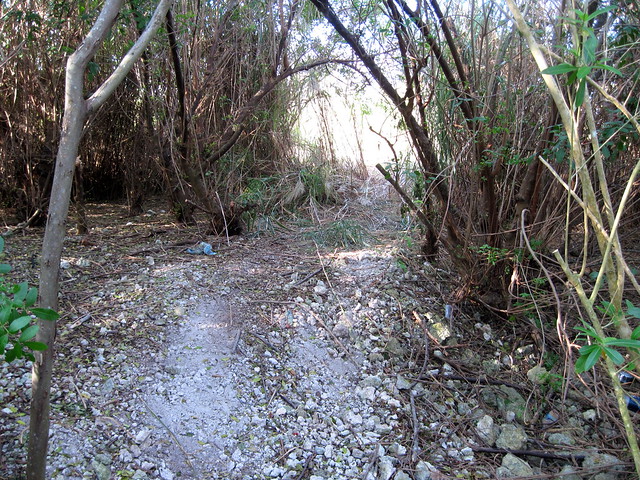
A large open area has been created by removal of most of the underbrush, and worst of all, the secluded area is being ravaged by “sport” riders of all-terrain vehicles. Instead of a dark cool place under a canopy of native Trema trees, it is now shaped like a doughnut, with full sky overhead, and a fire ring in the middle. Two of the five mature Tremas have been pulled over with chains, presumably attached to the ATVs, and a third is badly de-barked and will surely die. Tremas produce berries continuously all winter and are an important food source for birds and other wildlife. 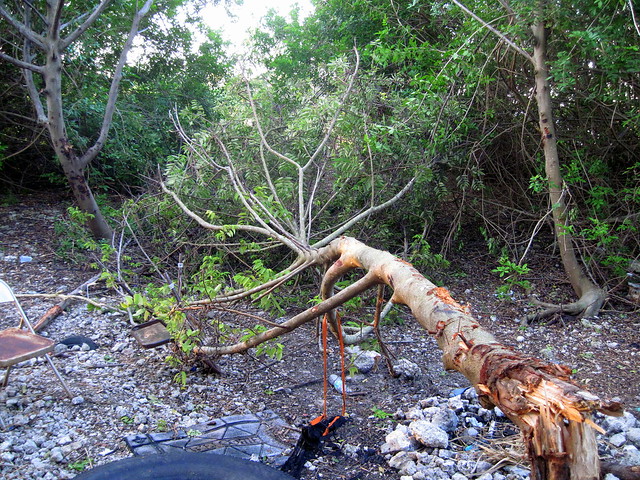
On a happier note, we have headed north, and hope to catch up with the spring warbler migration that, this year, has bypassed our Florida home.
Just before we left Florida, The first Yellow-crowned Night-Heron chicks began hatching. There were two chicks visible in this nest, which is totally open to view because of the defoliation of the nest tree by herbicides (See: Courting herons unaware of danger). Last year the nests were barely visible through the leaves. Now they are exposed to predators and any rock-throwing vandals who happen to notice them from across the 30 foot canal.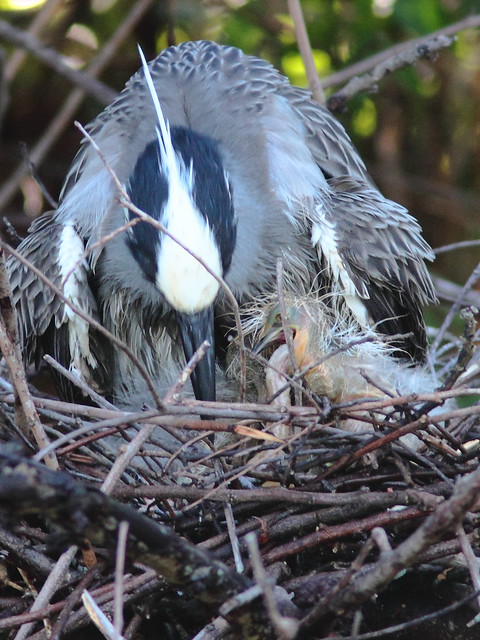
Look closely at the above photo and notice that one of the 3-5 day old chicks is trying very hard to swallow something that is awfully big. 
The prey item looks like a fat white creature– maybe a horsefly larva, but I could not be sure, as it looks larger, more the shape of a siren that has been skinned. Whatever it is, it may have been partly digested by the parent. The parent bird attempted to pull the partially-swallowed item out of
the chick’s mouth, but, despite its small size the chick resisted the adult’s attempts to dislodge it from its gullet, protesting vigorously.
Initially, the parentt’s efforts did not succeed. 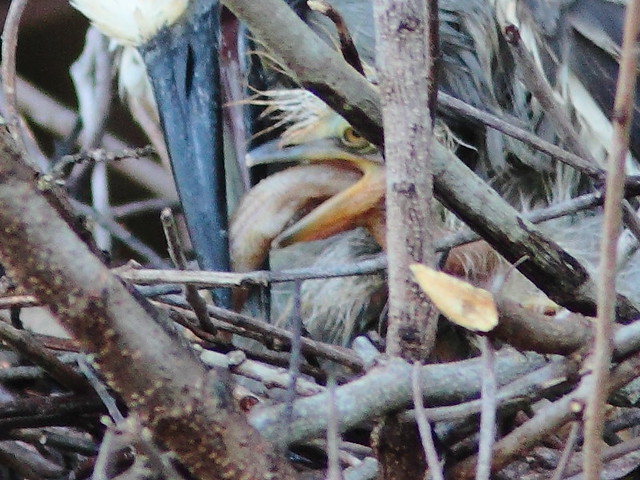
A few minutes later I captured this short video clip that demonstrates that the little guy finally gave up the prize, which was quickly swallowed by its parent.
Baby Yellow-crowned Night-Heron almost chokes to death from Ken Schneider on Vimeo.
If you have trouble viewing this VIMEO clip, here is a direct link to it on FLICKR.I have accumulated a backlog of non-heron and non-eagle images from our recent morning walks in our local wetlands. Among them:
Common Nighthawks arrived during the past two weeks.
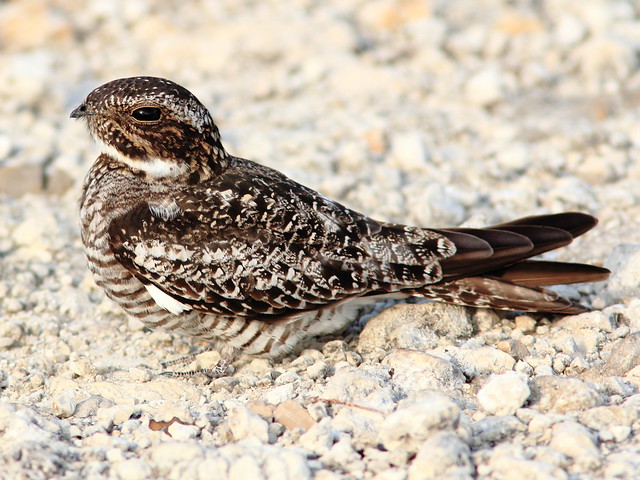
Their flight is so erratic and unpredictable that it is very hard to catch them in the viewfinder, much less get a decent photo when they are on the wing.

Here, the first light of morning creeps underneath an overflying nighthawk.
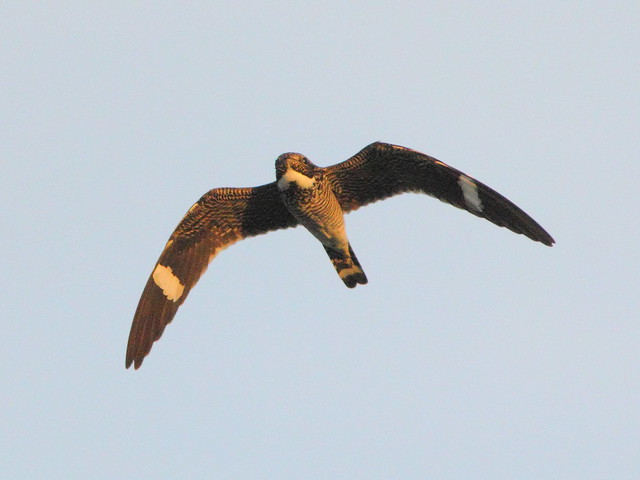
A male Eastern Towhee sings on territory. Its yellow eyes indicate that it is a local bird.
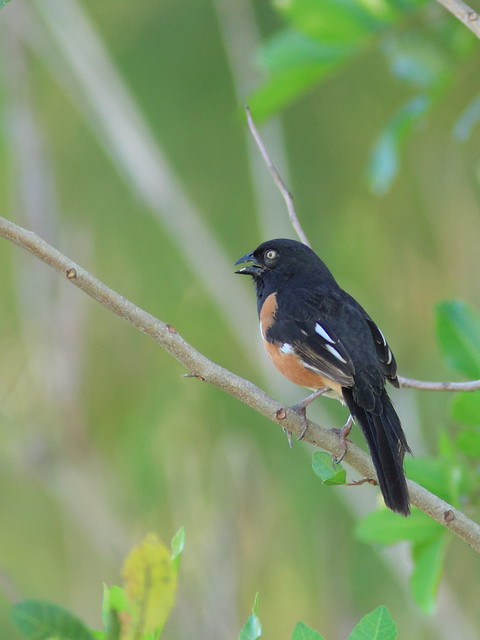
As usual, I do not pass by an opportunity to photograph a singing male Northern Cardinal.

This year, for the first time, we heard and saw Pileated Woodpeckers in our neighborhood. I finally find one out in the open.
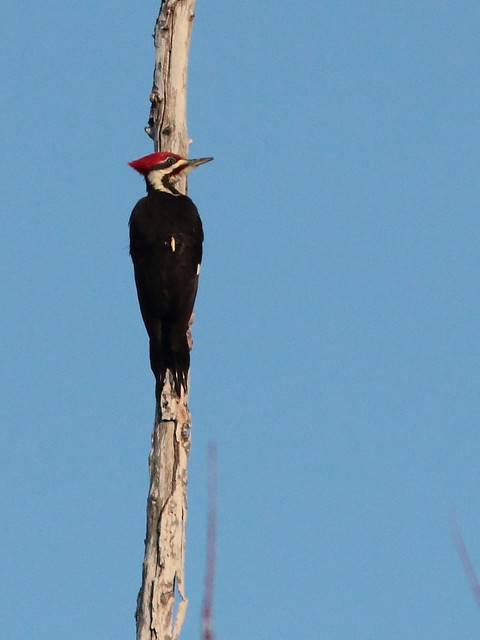
A flock of Cattle Egrets is joined by a lone Snowy Egret.

Another Snowy Egret casts its reflection in the stillness of a misty morning.

A Little Blue Heron is changing from the white phase of a juvenile into dark adult plumage .
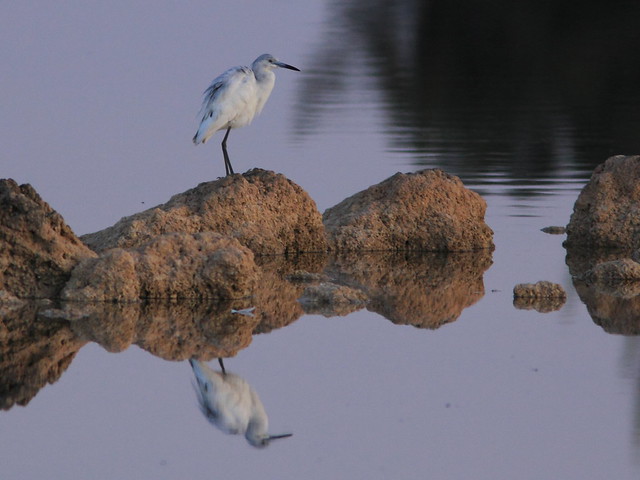
Nearby, a Great Egret barely disturbs the calm waters.
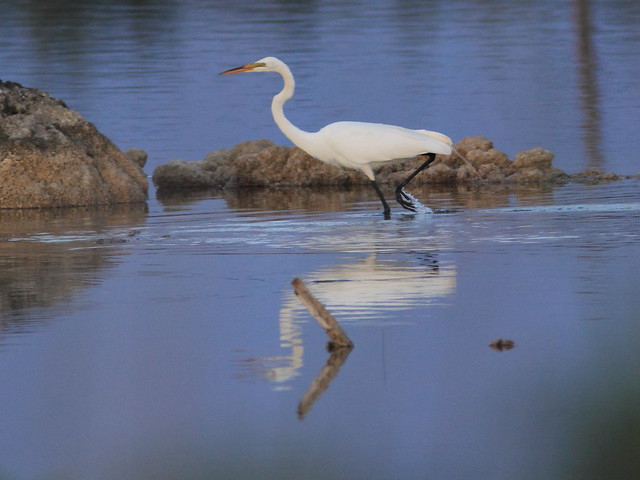
A pair of Mottled Ducks will also nest along the shore. The male, showing a clear yellow-green bill, is on the right.
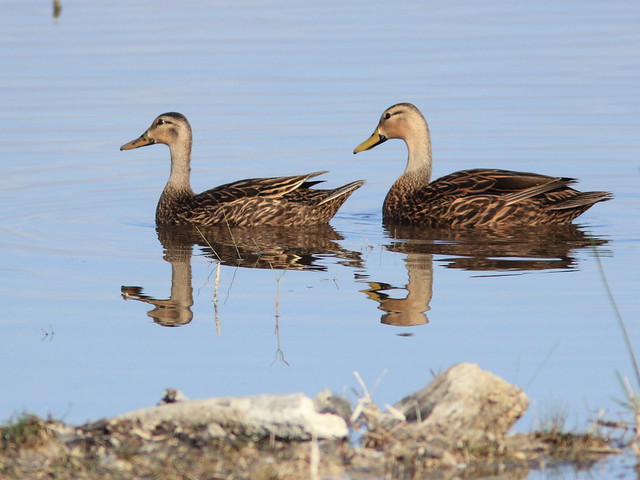
Later in the morning, a Killdeer flies by,
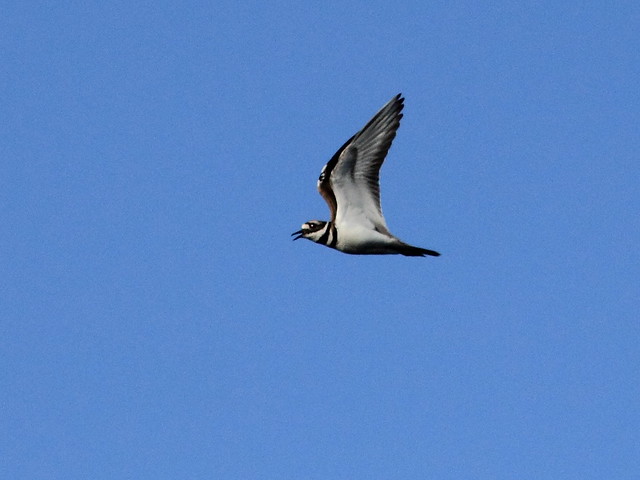
Killdeer may be planning to nest on this spit of land that has been exposed by the dropping water levels.
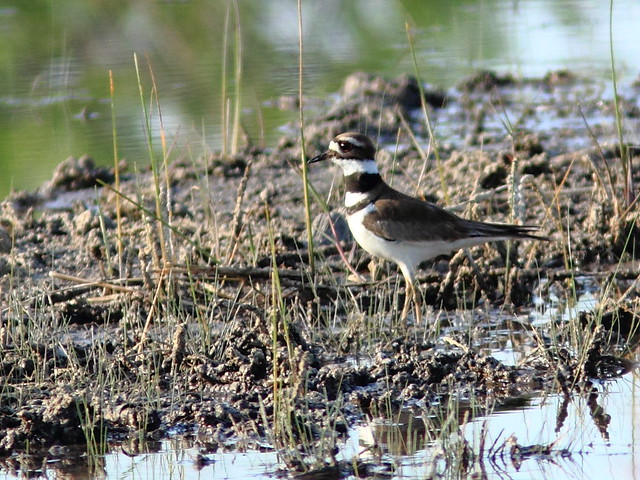
I am pleased to find a native Green Anole in our birding patch. They have been almost entirely displaced by exotic Brown Anoles.

A Black Vulture is graceful in flight.

A yearling female White-tailed Deer eyes us from the edge of a dense tract of exotic Melaleuca trees.

A curious (and presumably near-sighted) Raccoon stands on one foot, trying to figure out who is right in front of him/her in the trail:
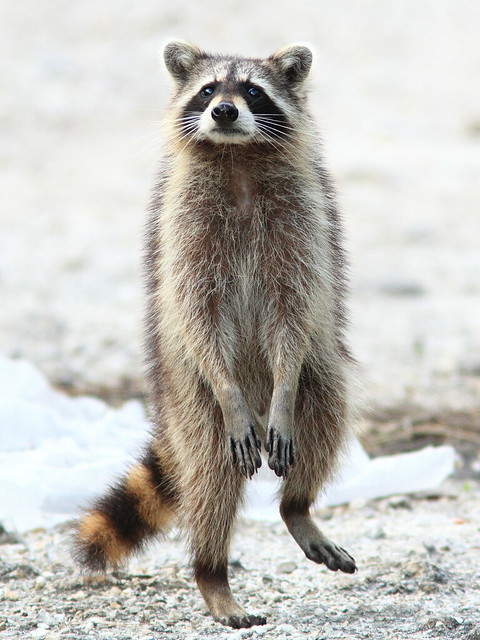
A Queen butterfly sips nectar from a Lantana flower
